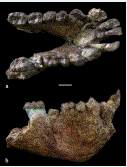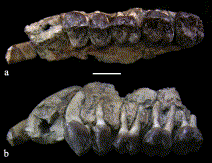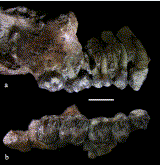James B. Rossie, Laura MacLatchy
Source - http://www.sciencedirect.com/science/article/pii/S0047248413001188
Journal of Human Evolution
Abstract
We describe here the well-preserved dentognathic remains of an Afropithecus individual from the early Miocene site of Kalodirr in northern Kenya. The specimen includes a nearly complete dentition in which most of the crowns are undamaged and unworn. The new information gleaned from this specimen adds to our knowledge of this genus in several ways. Afropithecus exhibits an atypical pattern of canine dimorphism, and is probably more easily sexed by the pattern of variation in its upper premolars. Both phenomena are likely related to the modification of its antemolar dentition for the purpose of sclerocarp harvesting. The new fossils clarify the role in this adaptation of the premolars, which appear specialized for initiating and propagating cracks in large food items bearing protective coats. Comparison with other Miocene apes suggests that the closest known relative of Afropithecus is Nacholapithecus, to which Equatorius is more distantly related. Morotopithecus shares some primitive traits with Afropithecus, but lacks the derived features shared by the latter and Nacholapithecus.

Figure 1. Mandible of KNM-WK 24300 in (a) occlusal and (b) right lateral view. Scale bar = 1 cm.

Figure 2. Left maxilla of KNM-WK 24300 in (a) occlusal and (b) lateral view. Scale bar = 1 cm.

Figure 3. Right maxilla of KNM-WK 24300 in (a) lateral and (b) occlusal view. Scale bar = 1 cm.